- home
- BAKERECIPES
BakeRecipes
Bringing real baking into your home with deliciously simple recipes.
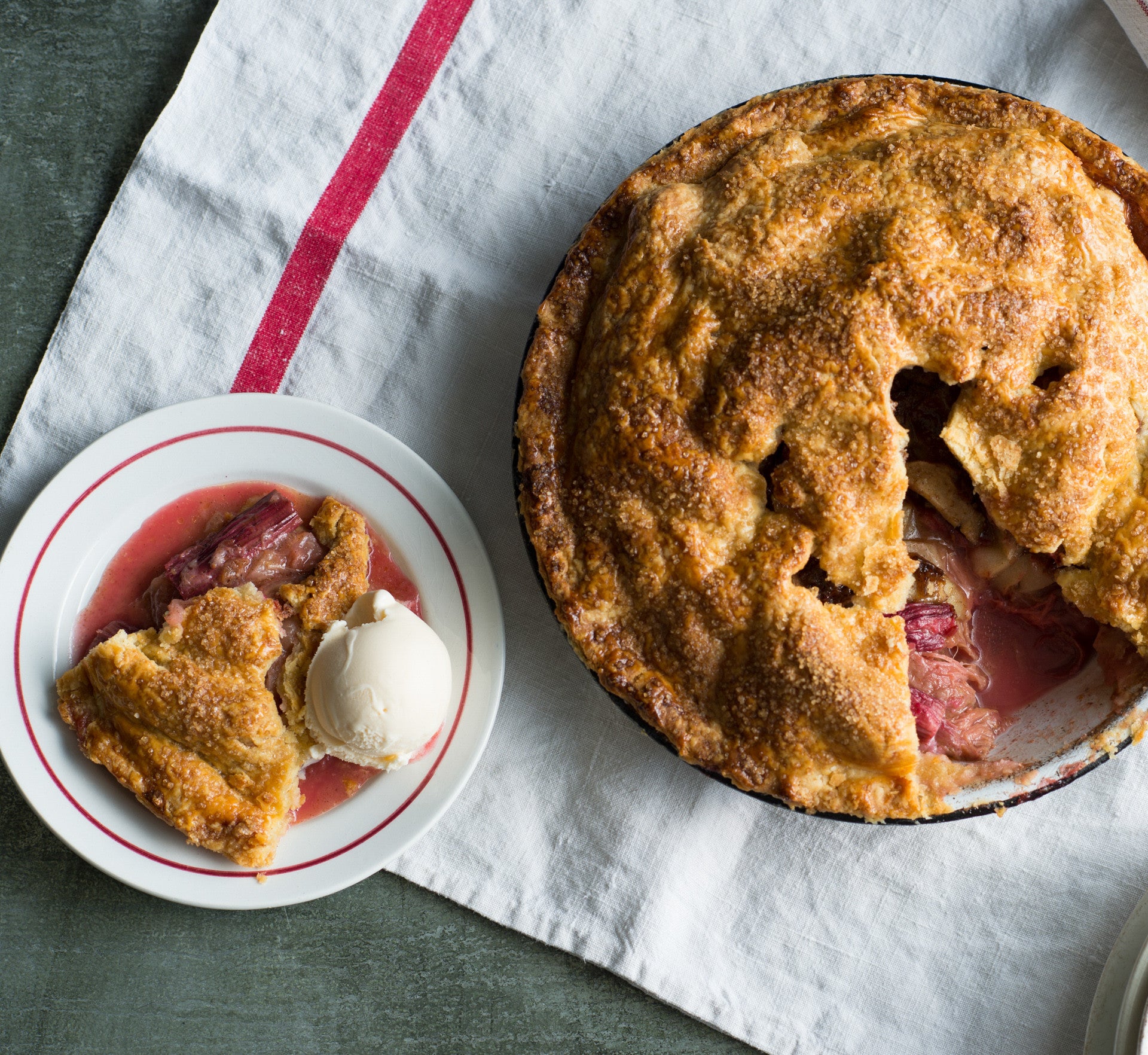
Prep 15min (+20min chilling time)Makes 8-10 serves
This pastry is rich, flavoursome and dead easy to make. It has a tender, melt-in-the-mouth texture, adding a beautiful richness to fruit-based pies. Avoid using with custard-based pies, as it will be too rich, and it's too fragile to use in free-form pies.
Ingredients
250g (1⅔ cups) plain flour
2 tablespoons caster sugar
good pinch of salt
180g cold unsalted butter, cubed
125g (125ml/½ cup) sour cream
2 teaspoons vanilla bean paste
Method
- Place the flour, sugar, salt and butter in the bowl of a food processor and process until the mixture resembles fine breadcrumbs.
- Add the sour cream and vanilla bean paste and use the pulse button to process briefly until the mixture just forms a ball.
- Turn the dough onto a lightly floured, cool benchtop and shape into a disc. Wrap in plastic wrap and chill in the fridge for 20 minutes to rest. Use as directed in this Rhubarb and Apple Pie.
Baker's Tips
- This pastry will keep wrapped well in plastic wrap in the fridge for up to 3 days. Stand at room temperature for about 1 hour (depending on the weather) until softened slightly and pliable enough to roll easily.
This recipe is from Anneka's SBS Food online column, Bakeproof: Pies.
CLICK HERE for more Bakeproof recipes.
Photography by Alan Benson.
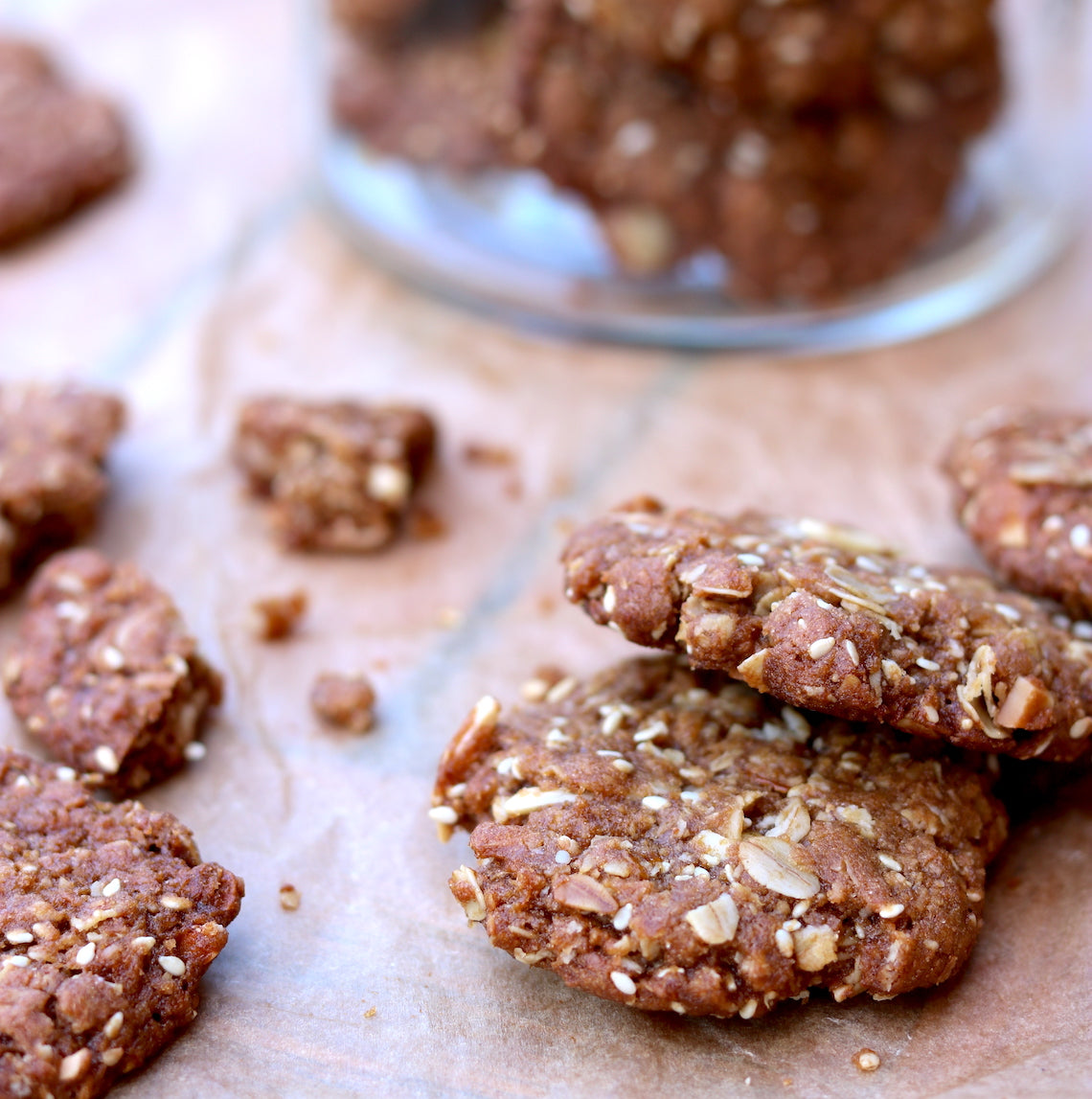
Prep 20minBake 20minMakes about 30
Reminiscent of the traditional and timeless Anzac biscuits, these morish treats have the addition of almond and sesame (for extra crunch) and mandarin (for a surprising flavour twist). This variation is not intended to be disrespectful of the ANZAC spirit – just a modern variation to enjoy with a cuppa and to reflect on the legacy left and sacrifice made by our service men and women.
Ingredients
95g (1 cup/3¼oz) rolled oats
150g (1 cup/5¼oz) plain flour
90g (1 cup/3oz) desiccated coconut
220g (1 cup, firmly packed/7¾oz) brown sugar
95g (¾ cup/3¼oz) slivered almonds
40g (¼ cup/1½oz) sesame seeds
Finely grated rind 1 mandarin
125g (4½oz) salted butter, cubed
2 tablespoons treacle
2 tablespoons water
½ teaspoon bicarbonate of soda
Method
- Preheat oven to 180°C/350°F (160°C/315°F fan-forced). Line 2 large oven trays with baking paper.
- Put the rolled oats, flour, coconut, brown sugar, almonds, sesame seeds and mandarin rind in a large mixing bowl and stir to combine.
- Put the butter, treacle and water in a small saucepan and heat over medium heat, stirring occasionally with a wooden spoon, until the butter melts and the mixture is hot. Remove from the heat, add the bicarbonate of soda and stir to combine – the mixture will foam. Add to the dry ingredients and stir with the wooden spoon until evenly combined.
- Roll tablespoonfuls of the mixture into balls and place about 5cm/2in apart on the lined trays. Use your fingers or the bottom of a glass to flatten the balls until about 1cm/½in thick.
- Bake in preheated oven for 20 minutes, swapping the trays after 10 minutes, or until golden and cooked through. Remove the biscuits from the oven and cool on the trays. Repeat with any remaining biscuit mixture.
Baker's Tip
- These biscuits will keep in an airtight container at room temperature for up to 2 weeks (if they last that long!)
Prep 30min (+ 1hr 30min proving time)Bake 25-30minMakes 16
There is nothing quite like a really good, simple white bread roll. These ones have a lovely soft crumb and a thin crust, perfect (as their name suggests) for dinner or as the Italians do, for breakfast with lashings of butter and jam or cheese.
Ingredients
500g (3⅓ cups) strong bread or pizza flour, plus extra to dust
1 tablespoon caster sugar
1 x 7g sachet instant dried yeast
1 teaspoon salt
375ml (1½ cups) lukewarm water
40g butter, melted and cooled, plus extra to grease
1 egg yolk whisked with 1 tablespoon milk, to glaze
Sesame and/or poppy seeds, to sprinkle
Method
-
Combine the flour, sugar, yeast and salt in a large bowl and make a well in the centre. Combine the water and butter, then add to the flour mixture. Use a wooden spoon and then your hands to mix to a soft dough.
-
Turn the dough onto a lightly floured surface and knead for 8-10 minutes or until it is smooth and elastic and springs back when you push your finger into it.
-
Brush a large bowl with melted butter to grease. Add the dough turning it to coat lightly with the butter. Cover with plastic wrap and place in a warm, draught-free place for 1 hour or until doubled in size.
-
Preheat oven to 200°C (180°C fan-forced). Line two oven trays with non-stick baking paper.
-
Knock back the dough by punching it in the centre with your fist. Turn onto a lightly floured surface and knead for 2-3 minutes or until smooth and elastic. Divide the dough into 16 equal portions. Shape each portion into a ball by rolling it on the bench and place on the lined trays leaving about 5cm between each. Cover with a slightly damp tea towel and set aside in a warm draught-free place for 30 minutes or until well risen.
-
Brush the rolls with the egg wash to glaze, sprinkle with sesame or poppy seeds and then bake in preheated oven for 25-30 minutes, swapping the trays halfway through baking, or until golden and sound hollow when tapped on the base. Transfer to a wire rack to cool.
Variations
- Oval Rolls: In Step 5, roll each portion of dough into an oval shape about 7cm long. Use a small sharp knife to cut a slit, about 1cm deep, along the length of the roll, starting and finishing about 1cm from each end, then continue with the recipe.
- Knot rolls: In Step 5, roll each portion of dough into a sausage shape about 30cm long. Tie into a loose knot and continue with the recipe.
Baker's Tips
- These rolls are best eaten the day they are made however they do freeze well – seal in a freezer bag and freeze for up to 1 month. Thaw at room temperature.
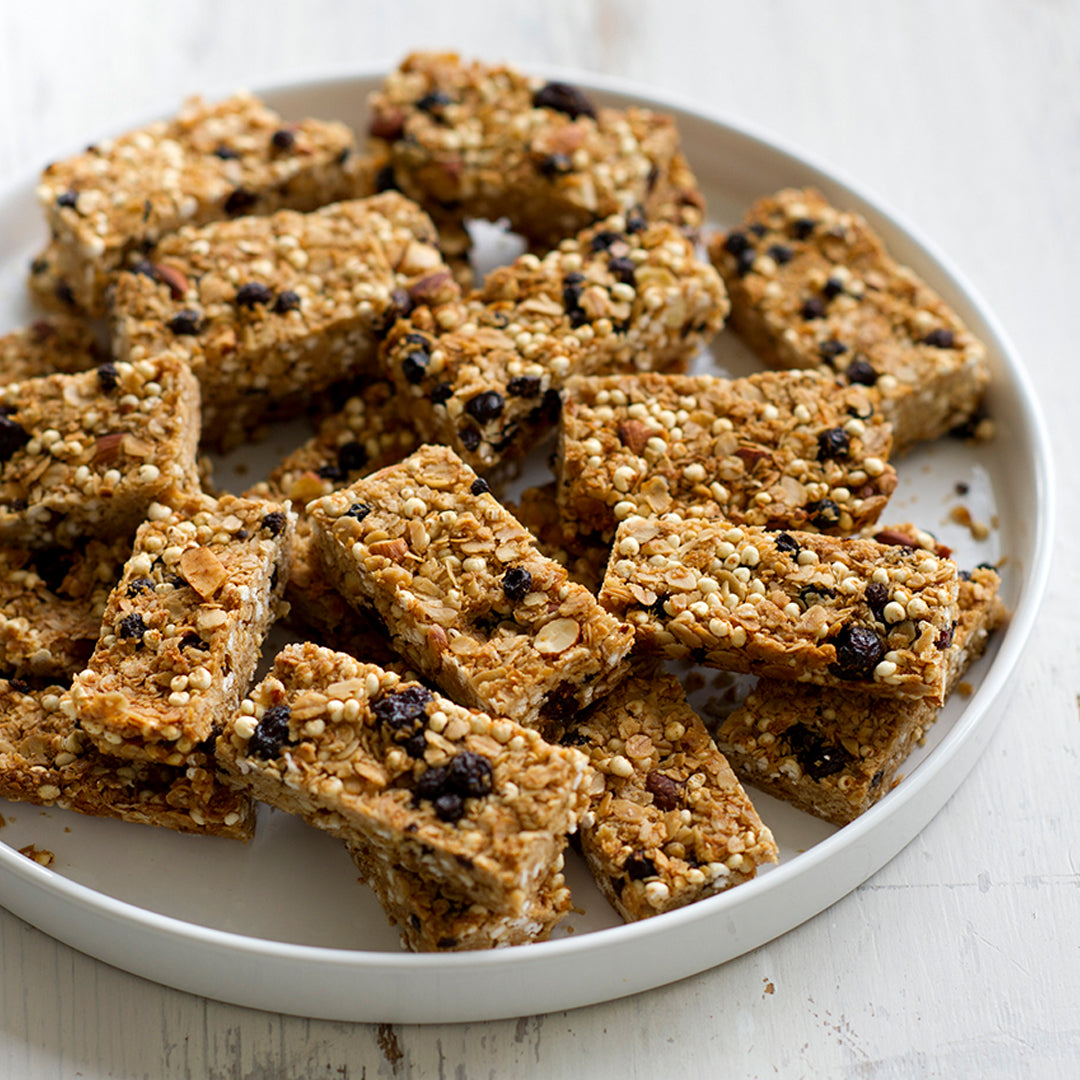
Prep 15min (+ cooling time)Bake 45-55minMakes about 24
Knowing what is going into your muesli bars is the key to good ones – it makes them so much healthier and tastier.
Ingredients
260g (180ml / ¾ cup) good-quality honey
125ml (½ cup) sunflower oil or light olive oil
250g (2½ cups) rolled oats
30g (1½ cups) puffed millet
45g (½ cup) desiccated coconut
1½ teaspoon ground cinnamon
55g (⅓ cup) sweetened dried cranberries
75g (½ cup) currants
80g (½ cup) raw almonds, coarsely chopped (see Baker’s Tips)
Method
- Preheat the oven to 140ºC (120°C fan-forced). Lightly grease a shallow 20 x 30cm (base measurement) slice tin and line the base and sides with non-stick baking paper.
- Put the honey and oil in a small saucepan over medium heat and stir until well combined and heated through. Set aside.
- Put the rolled oats, millet, coconut, cinnamon, cranberries, currants and almonds in a large bowl and mix to combine evenly. Add the honey mixture and stir to combine well. Using damp hands, press the mixture firmly into the lined tin. Press the mixture with the back of a spoon to make the surface smooth and even.
- Bake for 45–55 minutes or until the surface is dark golden brown all over. Cool completely in the tin before cutting into 24 bars with a sharp knife.
Baker's Tips
- For a nut-free version, substitute the almonds with ⅓ cup sunflower seeds or pepitas (pumpkin seeds).
- These muesli bars will keep in an airtight container at room temperature for up to 1 week. Alternatively they also freeze well for up to 3 months – wrap individual bars in plastic wrap and then seal in an airtight container or freezer bag. Thaw at room temperature.
- For extra-crisp muesli bars, store in an airtight container in the fridge.
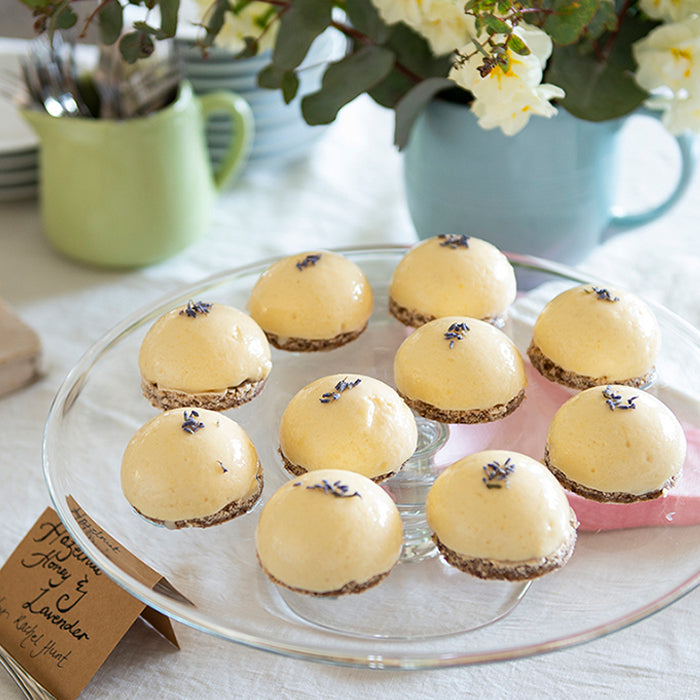
Prep 2 hours (+ 4 hours chilling time)Bake 30-40 minMakes 18 serves
These divine desserts petite gateaux were created by Rachel Hunt, one of our Make Me a Baker students for her graduation. A crisp, nutty, meringue base is topped with a mirror-glazed, ever-so-light honey-infused mousse surrounding a floral lavender jelly. Using a number of techniques, this recipe showcases all the fantastic new skills and confidence Rachel gained over the course of our 6-month program and, lucky for you, she’s sharing it so you can make them at home! Rachel uses 18 x 30mm and 60mm (top measurement) half sphere silicon moulds however other shapes/sizes can be used.
Ingredients
Lavender Jelly- 6 fresh unsprayed lavender heads or 2 teaspoons
dried culinary lavender, plus extra to decorate - 250ml (1 cup) water
- 110g (1/2 cup) sugar
- 1½ teaspoons powdered gelatin
- 2½ tablespoons cold water
- Purple food colour (optional)
- 5 eggs, separated
- 40g butter, diced
- 135g good-quality white chocolate chips (like Callebaut)
- 60ml (¼ cup) good-quality honey
- 2 teaspoons powdered gelatin
- 2 tablespoons cold water
- 300ml thickened cream
Hazelnut Meringue
- Vegetable oil, to grease
- 150g hazelnut meal or peeled toasted hazelnuts
- 7 large egg whites
- ½ teaspoon white wine vinegar
- 385g (1¾ cups) caster sugar
Mirror Glaze
- 2 tablespoon powdered gelatin
- 250ml (1 cup) cold water
- 330g (1½ cups) caster sugar
- 160ml (2/3 cup) sweetened condensed milk
- 2 cups good-quality white chocolate chips (like Callebaut)
Method
- To make the lavender jelly, combine the sugar and 250ml water in a small saucepan and stir over a low heat until sugar dissolves. Bring to the boil. Remove from the heat and add the lavender. Set aside to cool to room temperature.
- When the syrup is almost cool, place the cold water in a small heatproof bowl or dish and sprinkle the gelatin over. Set aside for 5 minutes or until the gelatin is fully rehydrated. Sit the bowl or dish into another bowl of hot water and stir until dissolved and the mixture is clear.
- Strain the jelly syrup through a sieve to remove the lavender. Transfer the gelatin mixture to a medium bowl and stir in the syrup until well combined.
- Tint the jelly syrup with purple food colouring if desired. Place 18 x 30mm (top measurement) half-sphere silicon moulds on a tray and pour in the jelly syrup (there will be some syrup left over and you can set it in other moulds or glasses if you wish). Place in the fridge to chill for at least 4 hours, or until well set.
- To make the honey mousse, lightly whisk the egg yolks and combine in a medium saucepan with the butter, chocolate and honey. Stir over low heat until the chocolate is just melted (be careful not to overheat). Transfer mixture to a large bowl.
- Place the cold water in a small heatproof bowl or dish and sprinkle the gelatin over. Set aside for 5 minutes or until the gelatin is fully rehydrated. Sit the bowl or dish into another bowl of hot water and stir until dissolved and the mixture is clear. Stir gelatin mixture into the chocolate mixture until combined. Cover and cool to room temperature, stirring occasionally.
- Use an electric mixer with a whisk attachment or a hand-held balloon whisk to whisk the cream in a medium bowl until soft peaks form. Fold the cream into the cooled chocolate mixture until just combined. Whisk the egg whites with a clean whisk in a large bowl until soft peaks form. Add half the egg whites into the chocolate mixture and gently fold through. Add the remaining egg whites and gently fold through until just combined.
- Place 18 x 60mm (top measurement) half sphere moulds on a tray and pour in the mousse mixture to fill each until almost full. Remove the lavender jelly domes from the smaller moulds and press into the centre of each individual mousse, ensuring the mousse completely covers the jelly. If the jelly isn't completely covered, add a little more mousse. If necessary, scrape a palette knife across the top of the moulds so that the base of the mousse domes will be level. Chill for at least 4 hours, or until set.
- To make the hazelnut meringue, preheat the oven to 180°C (160°C fan forced). Lightly grease 2 oven trays and line with non-stick baking paper.
- If using whole toasted hazelnuts grind the nuts with 1 tablespoon of the caster sugar in a food processor until fine but still with some texture.
- Use an electric mixer with a whisk attachment to whisk the egg whites and vinegar until soft peaks form. Add the caster sugar 1 tablespoon at a time, whisking well after each addition. Once half the sugar has been added start adding the rest in larger quantities, whisking well after each addition, until stiff, glossy peaks form. Use a metal spoon or spatula to fold the hazelnuts through the meringue. Spoon the meringue onto the prepared trays and spread evenly in a rectangle until about 1-1½cm thick. Bake in preheated oven for 30-40 minutes until a crisp crust forms. Remove from the oven and cool for 20 minutes on the trays and then transfer them to wire racks, still on the baking paper, to cool completely. Carefully remove the baking paper and transfer to a cutting board. Use a 6cm round cutter to cut discs from the meringue sheets. Set aside in an airtight container.
- To make the mirror glaze, place 80ml (1/3 cup) of the cold water into a small bowl or dish and sprinkle the gelatin over. Set aside for 5 minutes or until the gelatin is fully rehydrated.
- Combine the remaining water, sugar and condensed milk in a small saucepan over a medium heat. Stir occasionally until the mixture begins to bubble. Remove from the heat, add the gelatin mixture and stir until fully dissolved. Add the white chocolate chips and stir slowly until melted. Pour the mixture through a sieve into a large jug and set aside to cool to room temperature.
- Remove the petit gateaux domes from the fridge and place on a wire rack over a larger oven tray to catch the drips. Carefully and slowly pour the glaze over ensuring the domes are completely covered. Sprinkle dried lavender on top to decorate if desired.
- Set aside at room temperature for at least 20 minutes or until the glaze is set.
- Use a palette knife to transfer the mousse domes to the hazelnut meringue discs and serve.
Baker's Tips
- The mousse domes will keep in an airtight container in the fridge for up to 2 days.
- The Hazelnut meringue will keep in an airtight container at room temperature for up to 1 week.
Rachel took inspiration for her creation from:
https://www.deliciousmagazine.co.uk/
https://www.womensweeklyfood.com.au/
https://chelsweets.com
https://ballymaloe.ie/content/ballymaloe-recipes
Photography by Alan Benson.
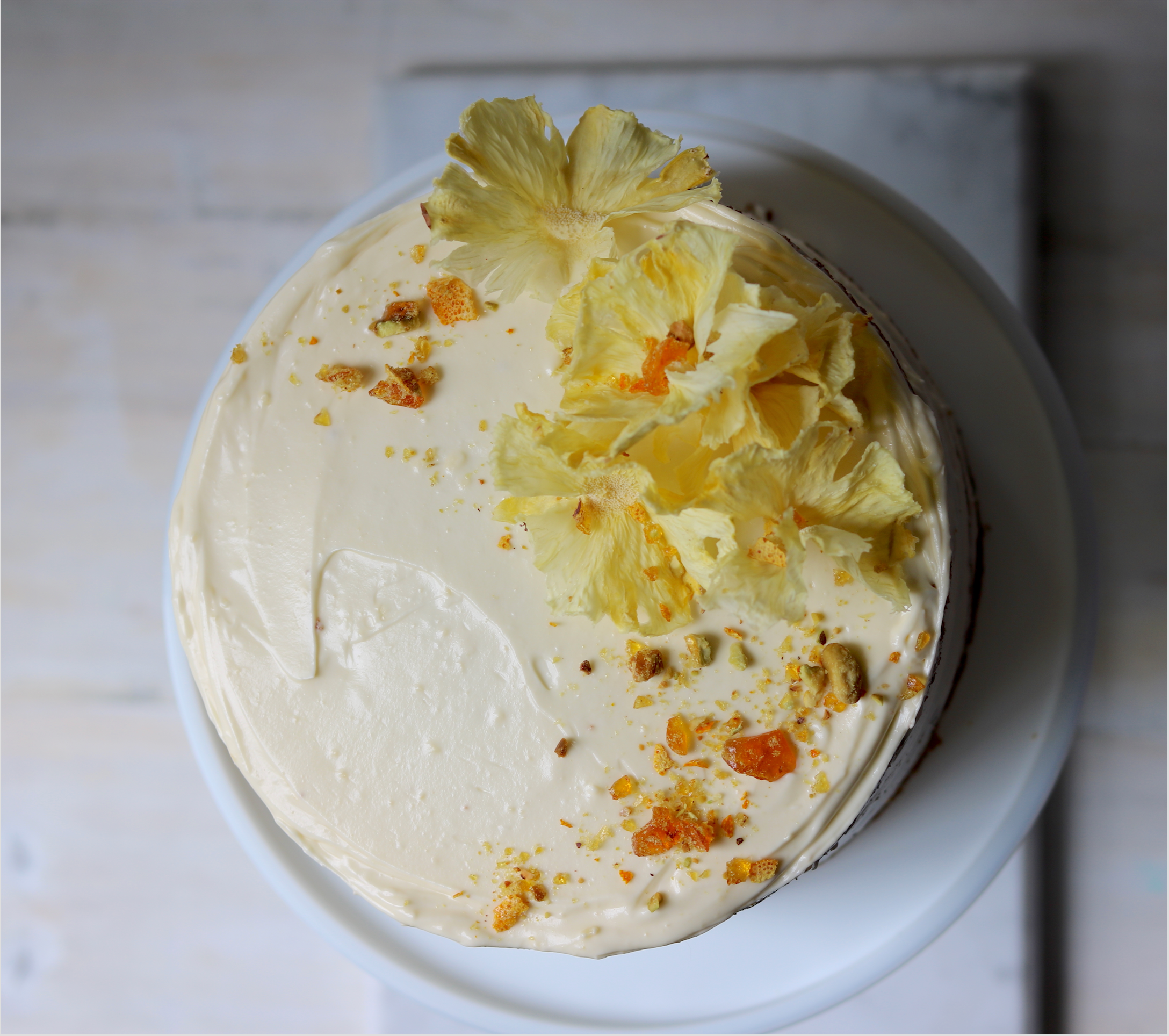
Prep 1hr30min (+ cooling time)Bake 3hr20minMakes 10-12 serves
I often create unique cakes for friends to celebrate special occasion and milestones – cakes that reflect their personalities and our friendship. This one was for my close friend, Tina, to celebrate her 50th. It is based on a recipe by well-respected Australian cooking teacher Greta Anna Teplitzky (from her cookbook The Greta Anna Recipes, published by Angus & Robertson in the 1970s). Tina’s mum made it often while she was growing up and it became childhood favourite. I have zhooshed the original up with a dried orange and pistachio praline and some fun dried pineapple flowers to match Tina’s gorgeous, vibrant and creative personality – quite appropriate I think!
Ingredients
Orange and pistachio praline
1 orange
45g (⅓ cup/1½oz) pistachios, lightly toasted
55g (¼ cup/2oz) caster sugar
1½ tablespoons water
Dried pineapple flowers
½ firm, ripe pineapple
Cake layers
300g (2 cups/10½oz) plain flour
2 teaspoons baking powder
1 teaspoon bicarbonate of soda
2 teaspoons mixed spice
300g (10½oz) brown sugar
200ml (7fl oz) light olive oil, plus extra to grease
4 eggs, at room temperature, lightly whisked
2 teaspoons natural vanilla essence or extract
450g (15¾oz) tin pineapple slices in syrup, drained and finely chopped
300g (2 cups, firmly packed/10½oz) coarsely grated carrot
Cream Cheese Frosting
250g (9oz) cream cheese, at room temperature
75g (2¾oz) salted butter, at room temperature
1 teaspoon natural vanilla essence or extract
185g (1½ cups / 6½oz) icing sugar mixture, sifted
Method
- To make the Orange & Pistachio Praline, preheat the oven to 100°C/212°F (80°C/175°F fan-forced). Remove the rind from the orange with a vegetable peeler and then use a small sharp knife to remove any white pith from the rind. Place the rind on a wire rack over an oven tray and place in the preheated oven for 2 hours or until dry and crisp but still bright orange in colour (see Baker’s Tips). Remove from the oven and set aside (leave the oven on). Line an oven tray with non-stick baking paper. Spread the pistachios and dried orange rind close together on the lined tray. Combine the caster sugar and water in a small saucepan and use a wooden spoon to stir over low heat until the sugar dissolves. Increase the heat to medium and bring to the boil. Boil for 8-10 minutes without stirring, brushing down the side of the pan with a pastry brush dipped in water to dissolve any sugar crystals, until the mixture turns a deep caramel. Pour immediately onto the lined tray over the pistachios and rind. Set aside to cool completely (this will take about 30 minutes). When cool, use a mortar and pestle to grind the toffee into a coarse praline. Transfer to an airtight container and set aside (see Baker’s Tips).
- To make the Dried Pineapple Fowers, stand the half pineapple upright on a cutting board and use a large sharp knife to cut off the skin in strips. Use a mandoline slicer to cut the pineapple into very thin rounds (about 1-2mm thick). Use a small sharp knife to remove any remaining dark bits of rind from the slices and then pat both sides with paper towel to remove any excess moisture. Place the slices on a wire rack on an oven tray (see Baker’s Tips). Place in the oven for 2½ hours or until crisp around the edges but still slightly pliable. Remove from the oven and pinch each slice in the center while still warm to form a flower. Set aside to cool and then store immediately in an airtight container until needed (see Baker’s Tips)
- To make the Cake Layers, preheat oven to 180°C/350°F (160°C/315°F fan-forced). Brush two 18cm/7in round cake tins with extra olive oil to lightly grease and line the bases with non-stick baking paper.
- Sift together 150g (1 cup/5 ¼oz) plain flour, 1 teaspoon baking powder, ½ teaspoon bicarbonate of soda and 1 teaspoon mixed spice into a large bowl. Add 150g (5 ¼oz) brown sugar and stir to combine, breaking up any lumps.
- Combine 100ml (3 ½fl oz) of the olive oil, 2 of the eggs, 1 teaspoon vanilla, half the chopped pineapple and 150g (5 ¼oz) of the grated carrot and mix well. Add to the flour mixture and use a spatula or large metal spoon to gently mix until just combined.
- Divide the mixture evenly between the prepared tins and spread with the back of a metal spoon to smooth the surface making a shallow well in the center of each cake. Bake in preheated oven for 25 minutes or until cooked when tested with a skewer.
- Stand the cakes in the tins for 5 minutes before turning onto wire racks to cool (this will take about 1 hour). Repeat with the remaining cake ingredients to make 2 more cake layers.
- To make the Cream Cheese Frosting, use an electric mixer to beat the cream cheese, butter and vanilla until very smooth. Gradually add the icing sugar, beating well after each addition and beat until well combined and very creamy.
- To assemble the cake, first trim the tops of the cake layers if necessary (if the well you made in the mixture before baking was deep enough you won’t have to do this). Place one cooled cake layer, top side up on a cake stand or serving plate. Spread with ½ cup of the Cream Cheese Frosting and then sprinkle with about 1½ tablespoons of the Orange & Pistachio Praline. Continue to layer with the remaining cake layers, spreading each with ½ cup of frosting and sprinkling with about 1½ tablespoons of praline, and finishing with a cake layer, top side down. Spread a thick layer of frosting over the top of the cake, evening the surface with a large palette knife. Spread any remaining icing around the side of the cake to create a ‘naked’ look. Decorate with the Dried Pineapple Flowers and sprinkle with a little of the remaining praline just before serving.
Baker's Tips
- You can dry the orange rind for the praline (in step 1) and the pineapple for the flowers (in step 2) at the same time if you like.
- The praline will keep in an airtight container for up to 2 weeks.
- You will only need 5-6 slices of pineapple to make the dried pineapple flowers for this cake but if you would like to make more, place the slices on an extra wire rack on top of the first one and separate the racks with balls of foil at the corners between them.
- The Dried Pineapple Flowers will keep in an airtight container in a cool spot for up to 4 days. If they soften and lose their shape, return to an oven preheated to 100°C/212°F (80°C/175°F fan-forced) for 20-30 minutes or until crisp around the edges again. Reshape as in step 2.
- This cake will keep in an airtight container in the fridge for up to 3 days. Stand at room temperature for at least 30 minutes before serving.
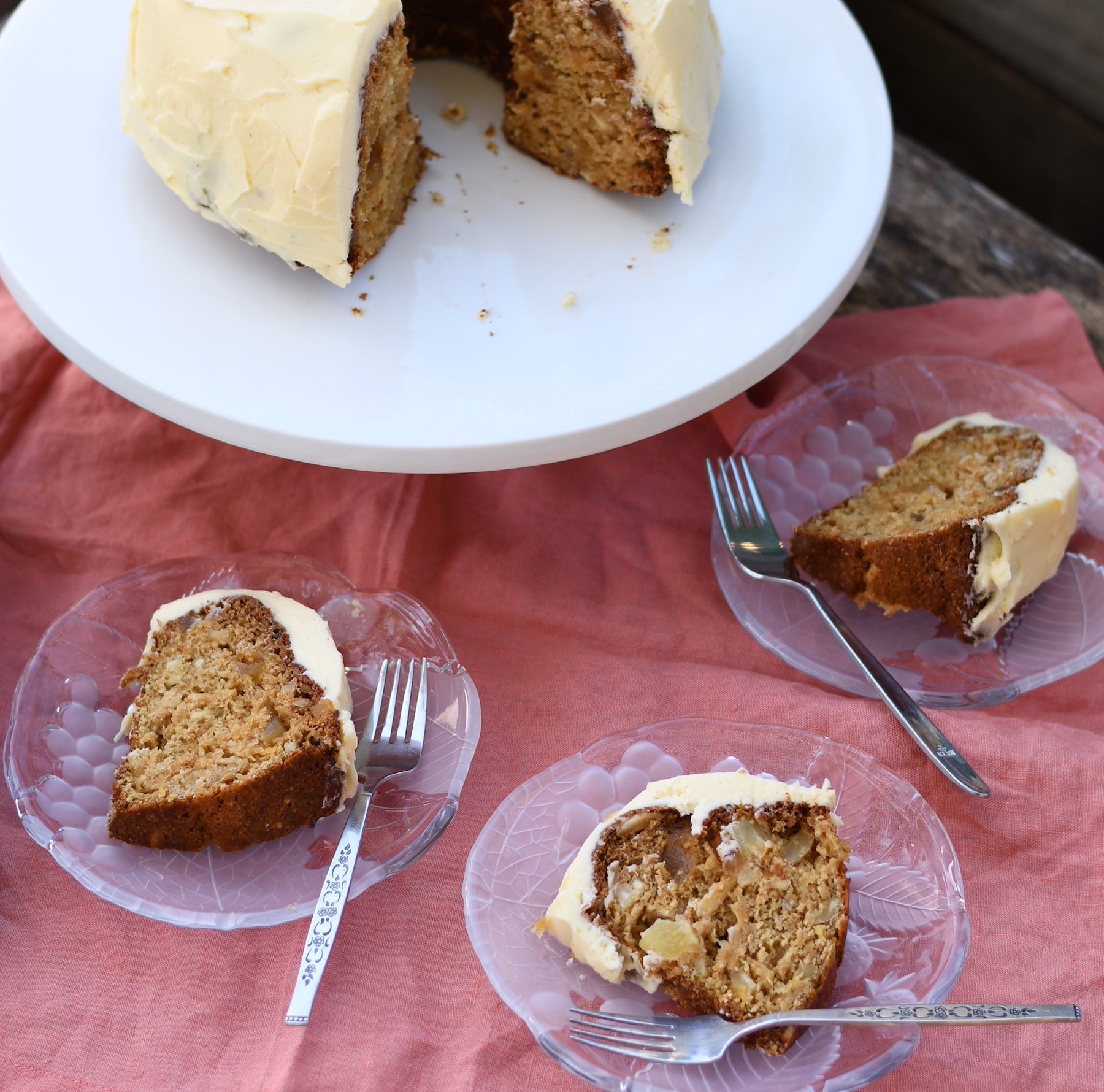
Prep 15 mins (+1 hour cooling)Bake 40minMakes 10 serves
This cake was shared by Hannah Scott as part of her Make Me a Baker program homework for Module 5.
"This sturdy but moist cake is a real crowd pleaser and a favourite in my family. To be honest, I’m not exactly sure why it’s called a Mexican Wedding Cake as I don’t think it’s traditionally served at weddings, but since my family usually make it for family gatherings and celebrations, the name has stuck. It’s super easy to make using the measure and beat method."
Ingredients
- 15g melted butter mixed with 1 teaspoon plain flour
- 310g plain wholemeal flour (unsifted)
- 2 teaspoons bicarbonate of soda
- 165g brown sugar
- 2 eggs, at room temperature, lightly whisked
- 85g slivered almonds
- 100g coarsely chopped glace ginger
- 450g tin crushed pineapple in natural juice, (with its juice)
Icing
- 75g butter, at room temperature
- 250g cream cheese, at room temperature
- 125g icing sugar, sifted
- 2 teaspoons natural vanilla extract or essence
Method
- Preheat oven to 180°C (160°C fan-forced). Brush a 2 litre (8 cup) fluted ring or bundt tin with the melted butter and flour mixture to grease.
- Place the flour, bicarbonate of soda, brown sugar, eggs, almonds, glace ginger and crushed pineapple into a mixing bowl and use an electric mixer to beat on low speed until well combined.
- Pour the cake batter into the prepared tin. Bake in preheated oven for 40 minutes or until a skewer inserted into the cake comes out clean.
- Stand the cake in the tin for 5 minutes before turning onto a wire rack to cool (this will take about an hour).
- Meanwhile, to make the Icing, use an electric mixer to beat the butter, cream cheese, icing sugar and vanilla until pale and creamy.
- Once cake has cooled completely, use the back of a metal spoon to gently spread the icing all over the cake. Serve in slices.
Baker's Tips
- This cake will keep in an airtight container in the fridge for up to 3 days. Serve at room temperature.
Hannah Scott (aka @thefoodstoryteller) won a scholarship to BakeClub's Make Me a Baker program thanks to SBS Food. Her rustic approach to baking is partly to thank for winning her the top spot in the competition. Stay tuned to Instagram and the blog to follow her Make Me a Baker journey over the next 6 months! In the meantime, click here to get to know a little more about her.
To find out more about how you can be part of a future Make Me a Baker program, click here.
Photography by Hannah Scott.

Prep 40minBake 8-10min (per batch)Makes 40
This recipe was created by Débora Bueno Leite, one of our Make Me a Baker students, as part of her graduation recipe – an impressive Romeo & Juliet Cake. The Macaron base is based on a recipe from a class she attended with MakMak Macarons, with the guava and cream cheese fillings her own creation to match the flavours of her cake which was inspired by a traditional pairing of guava and cheese known as ‘Romeo and Juliet’ in her native Brazil.
Ingredients
- 135g almond meal
- 135g pure icing sugar
- 2g red food colouring (water-based such as Queen Pillar Box Red)
- 145g egg whites (divided into 2 parts of 50g and 95g)
- 250g white sugar 60g water
Guava Filling
- 200g good-quality guava paste (available from good delicatessens and specialty food stores)
- 125ml (½ cup) water
Cream Cheese Filling
- 300g cream cheese, at room temperature
- 200ml cold thickened cream
- 160ml (2/3 cup) sweetened condensed milk
Method
- Preheat oven to 170°C (150°C fan-forced). Line 2-3 large baking trays with non-stick baking paper.
- Combine almond meal and pure icing sugar in a bowl and mix well. Pass this mix through a fine sieve.
- In a separate bowl, combine the red food colouring with 50g portion of egg whites. Add to the sifted almond meal and icing sugar and mix well until it becomes a homogenous paste (macaronage). Place the remaining 95g egg whites in the bowl of a stand mixer.
- In a small saucepan combine the white sugar and water. Stir over medium heat until the sugar dissolves completely and then bring to the boil. As soon as the mixture reaches 114°C on a sugar thermometer, start whisking the 95g portion of egg whites with a whisk attachment until soft peaks form.
- As soon as the sugar syrup reaches 118°C (soft ball stage), add to the egg whites in a steady steam, whisking constantly. Continue to whisk until the meringue cools so that the bowl is just warm to the touch.
- Weigh 190g of the finished meringue (use the remaining meringue can be used for another purpose). Add one-third of the 190g meringue portion into the red paste and mix well until it is evenly combined. Add the remaining two-thirds of the meringue to the coloured meringue mixture and fold gently together, making sure you scrape the bottom of the bowl, until just evenly combined (see Baker’s Tips).
- Transfer the batter into a piping bag fitted with a 1cm plain nozzle. Pipe rounds of batter ( about 4cm in diameter) onto the trays, leaving 2cm between each round. Tap the tray quite firmly on the bench to remove the air bubbles and settle the batter.
- Bake one tray of macarons at a time in the centre of the oven for 8-10 minutes. The macarons are ready when they no longer wobble when gently touched. Bake for another 1-2 minutes before testing again if necessary.
- Remove from oven and allow the macaron shells to cool completely on the trays.
- To make the Guava Filling, combine with guava paste and water in a small saucepan and stir over medium heat until the paste is creamy. Set aside to cool completely. Transfer the Guava Filling to a piping bag fitted with a 1cm plain nozzle. Set aside.
- To make the Cream Cheese Filling, use an electric mixer with a paddle attachment to beat the cream cheese for about 3 minutes or until soft and creamy; set aside. Whisk the cream with a balloon whisk or electric mixer with a whisk attachment in a clean bowl until soft peaks form. Add the cream cheese with the condensed milk and whisk until just combined and smooth. Transfer the Guava Filling to a piping bag fitted with a 1cm plain nozzle. Set aside.
- Carefully remove the shells from the trays and pair each with a like-sized shell. Pipe the guava paste onto the centre of a macaron shell and then pip the Cream Cheese Frosting around it. Sandwich with the paired macaron. Repeat with the remaining macarons and fillings.
- Place in an airtight container and refrigerate overnight before serving.
Baker's Tips
- When combining the meringue mixture with macaronage be careful not to over mix as it will ruin the rise of the shells. Once the batter looks evenly streaked by meringue and macaronage you will be about two-thirds of the way to competing the mixing and it is a good idea to slow down at this stage so you don’t overmix. Once evenly combined, the batter should not be shiny – if it is shiny, you have overmixed it.
Photography by Amy Piddington.
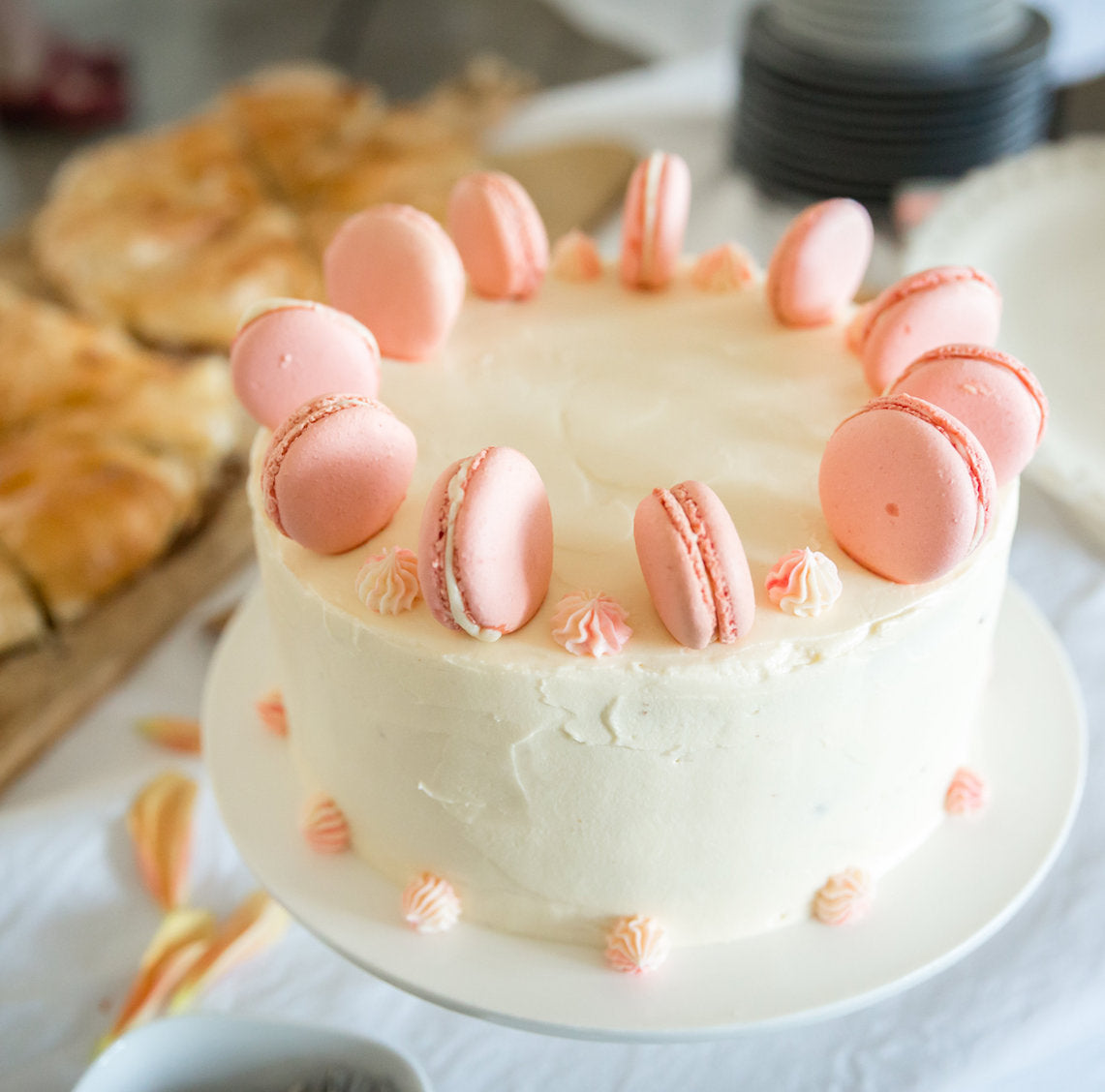
Prep 2hrBake 40-45minMakes 12-15 serves
This impressive cake was created by Débora Bueno Leite, one of our Make Me a Baker students, for her graduation. It marries two gems from the state of Minas Gerais in her native Brazil, guava paste and cheese – when served together they are known as ‘Romeo & Juliet'.
Ingredients
- 250ml (1 cup) milk combined with 2 tablespoons sweetened condensed milk
- 11 guava macarons, to decorate
Cake layers
- Melted butter, to grease
- 375g (2½ cups) plain flour
- 2½ teaspoons baking powder
- ½ teaspoon table salt
- 250g butter, at room temperature
- 440g (2 cups) caster sugar
- 1 teaspoon natural vanilla extract or essence
- 4 eggs, at room temperature
- 250ml (1 cup) full-cream milk
Guava Filling
- 200g good-quality guava paste (available from good delicatessens and specialty food stores)
- 125ml (½ cup) water
Cream Cheese Filling
- 300g cream cheese, at room temperature
- 200ml cold thickened cream
- 160ml (2/3 cup) sweetened condensed milk
Cream Cheese Frosting
- 680g cream cheese, at room temperature
- 115g unsalted butter, at room temperature
- 240g icing sugar, sifted
- 2 teaspoons natural vanilla extract or essence
- Queen red food colour gel, to tint
Method
- Preheat oven to 180°C (160°C fan-forced). Grease two deep 20cm round cake tins with melted butter and line the bases with non-stick baking paper.
- Sift together the flour, baking powder and salt into a medium bowl. Set aside.
- Use an electric stand mixer fitted with a paddle attachment to beat the butter, sugar, and vanilla for about 8 minutes, scraping down the side of the bowl when necessary, or until pale and creamy.
- Add the eggs, one at a time, beating well after each addition and scraping down the side of the bowl when necessary, until well combined.
- Add the flour mixture in four equal portions, alternating with the milk in three portions, mixing on lowest possible speed until just incorporated before adding the next; do not overmix.
- Divide the batter into the prepared tins and use the back of a metal spoon to smooth the surface. Bake in preheated oven, swapping the tins around halfway through baking, for 40-45 minutes or until a skewer inserted into the centre of the cakes comes out clean.
- Transfer the cake tins to a wire rack and allow the cakes to cool completely in the tins. Once cool, cover each tin tightly with plastic wrap and refrigerate overnight.
- To make the Guava Filling, combine with guava paste and water in a small saucepan and stir over medium heat until the paste is creamy. Set aside to cool completely.
- To make the Cream Cheese Filling, use an electric mixer with a paddle attachment to beat the cream cheese for about 3 minutes or until soft and creamy; set aside. Whisk the cream with a balloon whisk or electric mixer with a whisk attachment in a clean bowl until soft peaks form. Add the cream cheese with the condensed milk and whisk until just combined and smooth. Set aside.
- To make the Cream Cheese Frosting, use an electric mixer fitted with a paddle attachment to beat the cream cheese for about 3 minutes or until smooth and creamy; transfer to another bowl and set aside. Beat the butter about 3 minutes or until pale and creamy. Add the cream cheese, icing sugar and vanilla and beat until well combined and frosting is creamy.
- Remove the cakes form the tins. Cut each cake layer in half horizontally and then brush with the milk and sweetened condensed milk mixture to moisten. Place one layer on a serving plate or cake stand and spread with some of the Cream Cheese Filling and then one third of the Guava Filling. Continue layering with the remaining cake layers, Cream Cheese Filling and Guava Filling, finishing with a cake layer, top side down.
- Spread the side and top with Cream Cheese Frosting to cover, using a spatula or cake scraper to smooth evenly.
- Add a little red gel colour to the remaining Cream Cheese Frosting and swirl so that it is marbled. Place in a piping bag fitted with a small star nozzle (Débora used a Wilton #18 star) and pipe small rosettes around the side and top of the cake (as shown in the image). Place the macarons between the rosette on the top to decorate.
Baker's Tips
- This cake will keep in an airtight container in the fridge for up to 3 days. Serve at room temperature.
This recipe was created by Débora for her Make Me a Baker graduation using inspiration from a number of different recipes including those from www.howtocakeit.com, Gretchen’s Bakery YouTube channel, Karen Munhoz YouTube channel and a class she took with MakMak Macarons.
Photography by Amy Piddington.

Prep 30min (+15min cooling and 1hr standing time)Bake 15minMakes 20
The German word spritzen means to squirt and reflects the way these cookies are shaped – by pushing them through a piping nozzle. The almond meal in the dough gives a lovely soft, almost cakey, texture to these chocolate-dipped cookies that can be piped in various designs, including mini wreaths.
Ingredients
- 250g butter, softened
- 220g (1 cup) caster sugar
- 1½ teaspoon natural vanilla essence or extract
- 3 eggs
- 450g (3 cups) plain flour
- 60g almond meal
- 300g good-quality dark chocolate (45-54% cocoa), chopped
Method
- Preheat oven to 180°C (160°C fan-forced). Line two large oven trays with non-stick baking paper.
- Use an electric mixer to beat the butter, sugar and vanilla until pale and creamy. Add the eggs, one at a time, beating well between each addition. Combine the flour and almond meal. Add to the butter mixture and beat on the lowest possible speed until just combined.
- Spoon half the mixture into a large piping bag fitted with a 13 mm (#13) star nozzle. Pipe 6–7 cm circles onto the lined trays (see Baker’s tips). Repeat with the remaining mixture.
- Bake for 15-18 minutes, swapping the trays halfway through baking, or until pale golden and cooked through. Cool on the trays.
- Place the chocolate in a heatproof bowl over a saucepan of simmering water and heat, stirring occasionally, until melted. Turn off the heat but leave the bowl sitting on top. Dip a cooled cookie into the chocolate to coat half of the cookie. Place back on the lined tray and repeat with the remaining cookies. Tap the trays on the benchtop lightly to settle the chocolate into the grooves of the cookies, then set aside for about 1 hour or until the chocolate sets.
Baker's tips
- You can use a 6–7 cm round cutter as a guide to draw circles onto the underside of the baking paper to help keep your cookies uniform in size.
- These cookies will keep in an airtight container at room temperature for up to 1 week.
This recipe is from Anneka's SBS Food online column, Bakeproof: Festive Cookies.
CLICK HERE for more Bakeproof columns and recipes.
Photography by China Squirrel.
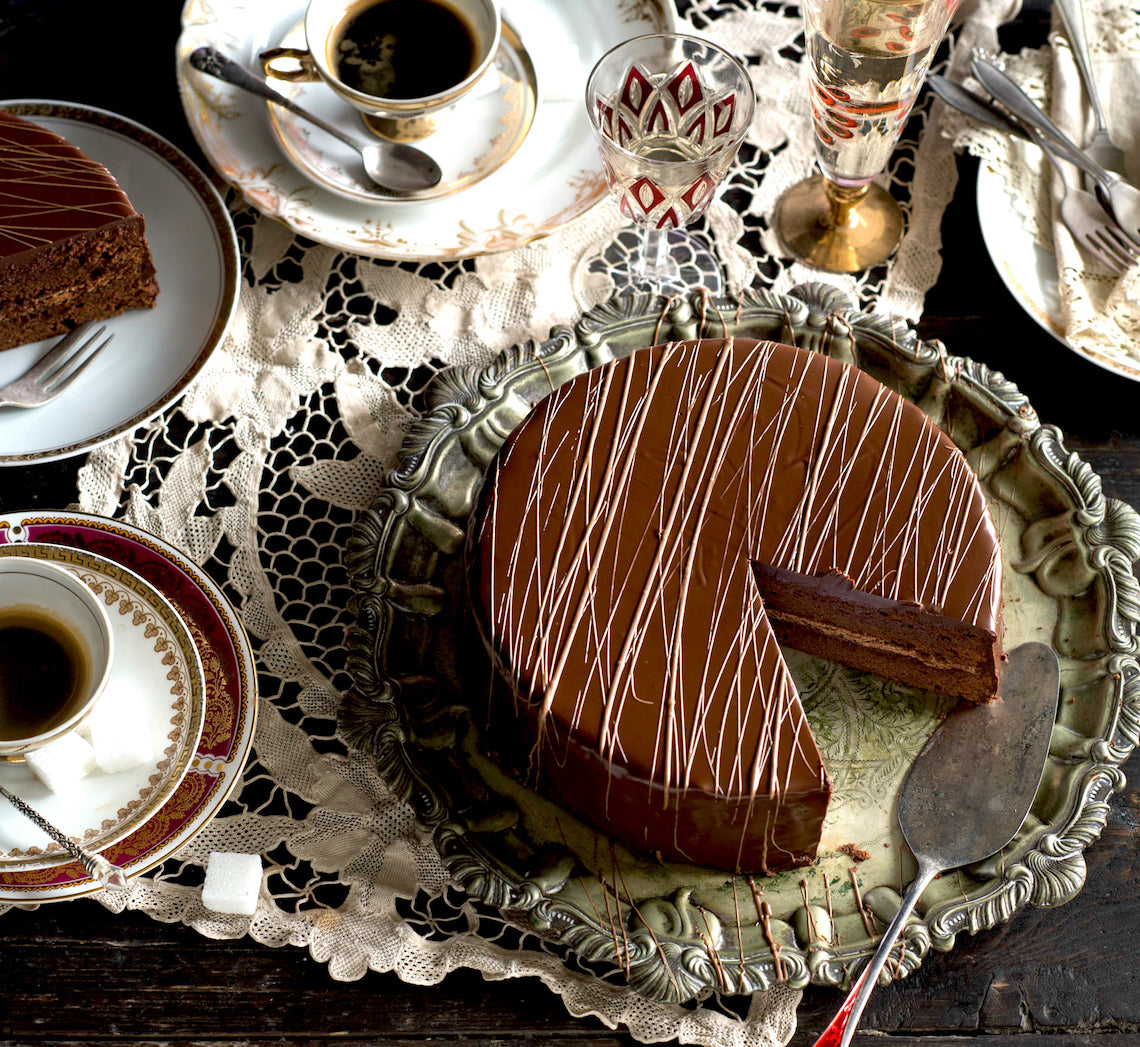
Prep 40min (+1hr cooling and 2hr standing time)Bake 30minMakes 10-12 serves
Possibly the most famous cake in the world, and certainly the pride of Austria, Sacher Torte was created by Franz Sacher, a 16-year-old apprentice stepping in for an ill head chef, to impress the guests of Prince Wenzel von Metternich. And as they say, the rest is now cuisine history. This elegant, rich and enticing cake is now loved the world over.
Ingredients
Melted butter, to grease
125g unsalted butter, softened
125g (1 cup) icing sugar, sifted
1½ teaspoons natural vanilla essence or extract
6 eggs, at room temperature, separated
175g good-quality dark chocolate (54% cocoa), chopped, melted and cooled to room temperature
110g (¾ cup) plain flour
110g (½ cup) caster sugar
85g (¼ cup) apricot jam, warmed and sieved
40g good-quality milk chocolate, melted, to decorate
Thick or whipped cream, to serve
Chocolate Glaze
300g good-quality dark chocolate (54% cocoa)
60g butter, cubed
Method
- Preheat oven to 180°C (160°C fan-forced). Brush 2 x shallow 20cm round cake tins with melted butter to grease and line the bases with rounds of non-stick baking paper.
- Use an electric mixer to beat the butter, icing sugar and vanilla until pale and creamy. Add the egg yolks and beat until well combined and creamy. Beat in the cooled melted chocolate until well combined. Use a large metal spoon or spatula to fold in the flour until just combined.
- Use an electric mixer with a whisk attachment to whisk the egg whites in a large clean, dry bowl until soft peaks form. Add the caster sugar and whisk on medium-high speed until thick and glossy and all the sugar has dissolved (see Baker’s tip). Add half the egg white mixture to the chocolate mixture and use a large metal spoon or spatula to fold in to ‘loosen’ the mixture. Add the remaining egg white mixture and fold until just evenly combined.
- Divide the mixture evenly between the tins and use the back of a spoon to smooth the surface. Bake in preheated oven for 30 minutes or until a skewer inserted into the centre of the cakes comes out clean. Stand in the tins for 10 minutes before turning onto a wire rack to cool (this will take about 1 hour).
- Once cool, spread one cake layer with the warmed sieved jam and then top with the second layer, bottom side up. Place the cake on a wire rack over a tray and set aside while making the chocolate glaze.
- To make the chocolate glaze, combine the chocolate and butter in a heatproof bowl and place over a saucepan of barely simmering water (make sure the base of the bowl doesn’t touch the water). Stir occasionally until just melted and combined. Use a plate knife to spread a little of the glaze over the outside of the cake to form a ‘crumb coat’ and to even the surface. Place in the fridge for 20 minutes or until set. Remove from the fridge and carefully pour over the rest of the glaze, allowing it to run down the sides of the cake to coat evenly. Tap the cake, still on the rack, gently on the tray to remove any air bubbles and to settle the glaze. Use a fork to drizzle the milk chocolate over the top of the cake to decorate. Set aside for 2 hours or until the glaze sets. Serve cut into small wedges with cream.
Baker’s Tips
- To test if all the sugar has dissolved, rub a little of the egg white and sugar between two fingers – you will be able to feel if there is still undissolved sugar. Whisk for another minute if not completely dissolved before testing again.
- This cake will keep in an airtight container at room temperature for up to 4 days.
This recipe is from Anneka's SBS Food online column, Bakeproof: Austrian Baking.
CLICK HERE for more Bakeproof columns and recipes.
Photography by Alan Benson.

Prep 25min (+ cooling and chilling time)
This recipe was created by Lisa Frost, one of our Make Me a Baker graduates, to use as part of her Graduation cake recipe. She wanted to create a curd she could use in, and serve with, the vegan cakes she was baking through her baking business, The Naked Lion Co. The result was this egg- and butter-free rich curd that will bring sunshine to any cake or dessert.
Ingredients
125ml (½ cup) strained fresh lemon juice
165-220g (¾-1 cup) caster sugar (depending on sweetness preferred)
40g (⅓ cup) cornflour
Pinch salt
Pinch ground turmeric
20g coconut oil
1 tablespoon coconut cream
Method
- Combine the lemon juice, sugar, cornstarch and salt in a small saucepan. Cook over a medium-high heat, stirring constantly, until it thickens and comes to a simmer.
- Remove from the heat and stir in the turmeric, or enough to reach the rich yellow colour typical of lemon curd. Mix in the coconut oil and then add the coconut cream, a little at a time until the curd reaches a good consistency (it will thicken a little more on cooling).
- Place mixture into a medium bowl. Cover the surface with plastic wrap and set aside to cool. Refrigerate for 3 hours or until well chilled before using.
Baker's Tips
- This lemon curd will keep well in a sealed jar in the fridge for 1-2 weeks.






